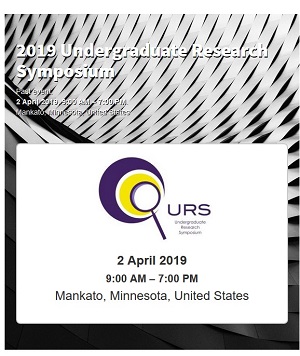Using Fluorescence Spectroscopy to Predict Photochemical Production of Reactive Intermediates in Minnesota Surface Waters
Location
CSU Ballroom
Start Date
2-4-2019 10:00 AM
End Date
2-4-2019 11:00 AM
Student's Major
Chemistry and Geology
Student's College
Science, Engineering and Technology
Mentor's Name
John Thoemke
Mentor's Department
Chemistry and Geology
Mentor's College
Science, Engineering and Technology
Description
The widespread problem of organic contaminants found within our surface waters is jeopardizing the health of the people, plants, and communities supported by these aquatic ecosystems. Pollutants such as pesticides, and pharmaceutical and personal care products, can be detrimental to the overall quality of the environment. Understanding how these pollutants are transported and transformed in surface waters, and finding ways to remove these pollutants from our lakes and rivers is a subject of ongoing scientific inquiry. One agent critical in the process of improving the quality of our water is dissolved organic matter (DOM). DOM is a diverse mixture of organic compounds that takes on many roles in aquatic systems, such as initiating photoreactions. Upon absorbing sunlight, DOM is promoted to an energetically excited state, and these excited state molecules are known as photochemically-produced reactive intermediates (PPRI). PPRI react with many of the organic contaminants found in surface waters. Previous work has demonstrated that the source material of the DOM can affect its capacity for producing PPRI, and that fluorescence spectroscopy can be used to partially determine the source material for a specific DOM sample. We have acquired fluorescence spectra for water samples throughout Minnesota, and using parallel factor analysis (PARAFAC) have begun to develop a model that will, when coupled with previously developed correlations between fluorescence spectral features and molecular components, help to refine predictions of PPRI production based on the source material of the DOM.
Using Fluorescence Spectroscopy to Predict Photochemical Production of Reactive Intermediates in Minnesota Surface Waters
CSU Ballroom
The widespread problem of organic contaminants found within our surface waters is jeopardizing the health of the people, plants, and communities supported by these aquatic ecosystems. Pollutants such as pesticides, and pharmaceutical and personal care products, can be detrimental to the overall quality of the environment. Understanding how these pollutants are transported and transformed in surface waters, and finding ways to remove these pollutants from our lakes and rivers is a subject of ongoing scientific inquiry. One agent critical in the process of improving the quality of our water is dissolved organic matter (DOM). DOM is a diverse mixture of organic compounds that takes on many roles in aquatic systems, such as initiating photoreactions. Upon absorbing sunlight, DOM is promoted to an energetically excited state, and these excited state molecules are known as photochemically-produced reactive intermediates (PPRI). PPRI react with many of the organic contaminants found in surface waters. Previous work has demonstrated that the source material of the DOM can affect its capacity for producing PPRI, and that fluorescence spectroscopy can be used to partially determine the source material for a specific DOM sample. We have acquired fluorescence spectra for water samples throughout Minnesota, and using parallel factor analysis (PARAFAC) have begun to develop a model that will, when coupled with previously developed correlations between fluorescence spectral features and molecular components, help to refine predictions of PPRI production based on the source material of the DOM.
Recommended Citation
Wright, Zoe. "Using Fluorescence Spectroscopy to Predict Photochemical Production of Reactive Intermediates in Minnesota Surface Waters." Undergraduate Research Symposium, Mankato, MN, April 2, 2019.
https://cornerstone.lib.mnsu.edu/urs/2019/poster-session-A/18



